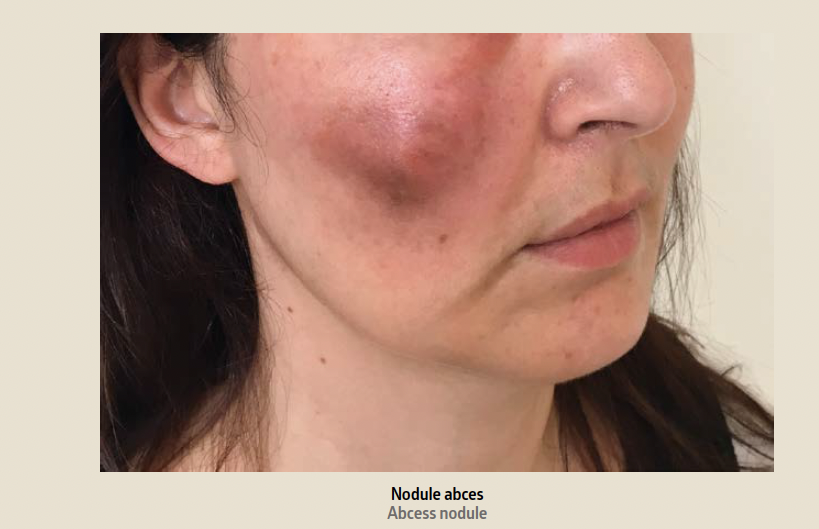Dr Isabelle Rousseaux
A lot has been said and published about the side effects of hyaluronic acid (HA) injections.
Anyone injecting cross-linked HA should know all of the possible side effects, how to prevent them and how to treat them. It is also a good idea for them to have a specialist doctor on hand to contact, if required. I have not done any academic studies into the subject, but I have listened to doctors for many years so I can provide a useful overview. This kind of modified HA takes some time to be fully eliminated, depending on how it is cross-linked, the amount injected and the depth and way it is injected, which explains why the side effects can only appear years later.
 It seems logical that a product that starts out natural and is later modified can lead to a reaction when injected into the skin:
It seems logical that a product that starts out natural and is later modified can lead to a reaction when injected into the skin:
- A high degree of cross-linking will create HA with a long lifespan, since the elimination process is slowed down. On the flip side, these HAs are difficult to treat with hyaluronidase (6).
- The quantity injected plays an important role, as the skin is likely to react more to a large bolus of HA: extensive work would involve more than 4 syringes, medium would be between 2 and 4, and light would be less than 2.
- The injection depth is also very important: intradermal with fine needles for skinboosters or superficial injections for mild wrin-kles. That said, these cross-linked HAs should not be injected in large quantities, otherwise it could lead to small, visible nodules that can last for months. Deeper injections are carried out into the hypodermis, above and below the muscles or above the perios-teum, and require faultless knowledge of the anatomy. A cannula is most often used in order to reduce the risk of embolism.
Bacterial side effects are almost inexistent nowadays: the germs either get into the syringe, which is not possible unless it is touched, or they get in through the needle, which is also impossible because everything is carefully disinfected. The only risk is with fake injectors, of course. We now recommend not using a syringe that has already been opened, as it is no longer sterile. A herpes fl are-up may appear after a few days, but this is easily treated. Serious vascular side effects come on quickly in the shape of vascular embolisms, which are well known nowadays and have a standardised treatment. There is still a risk of retinal embolism, which is an ophthalmic emergency (90 mins).
The signs of an embolism are easy to spot:
- Intense pain during injection, though this is unusual because the lidocaine masks it.
- The skin goes white, then livedo reticularis gradually appears over the next few hours.
- Blisters and scabs appear, then the skin is no longer vascularised properly and necrosis occurs. It is important to try to avoid rea-ching this stage. What to do: Hyaluronidase should be injected as quickly as possible, so as to avoid any scarring, according to the protocol of Dr P. Kestemont and colleagues (4).• Stage 1: 1500U / 1 to 5ml of 0.9% NACL serum using the nappage technique with a 25G cannula, to be repeated every 8 hours until the skin’s vascularisation gets back to normal when pressed.
- Stage 2: 1500U every 6 hours• Stage 3: 1500U every 2 hours
 The multiple recommendations to take great care and use a cannula for high-risk areas (nasolabial folds, glabellar, nose) are star-ting to reap benefits.
The multiple recommendations to take great care and use a cannula for high-risk areas (nasolabial folds, glabellar, nose) are star-ting to reap benefits.
Nodule-type side effects can follow injection:
– Quick cold nodules: these are often down to an excess of product
– What to do: wait or use hyaluronidase.
– Hot inflammatory nodules and/or oedema can appear immediately or later on. Their origin can sometimes be identified or suspected, but this is tricky even after questioning:
- Exposure to heat
- Concomitant dental or gum issues
- Shearing of the masticator, temporal or masseter muscles, or too-strong muscles such as the mentalis or masseter.
- Injection of volumisers to superficially and/or in too large a quantity.
- High stress levels, which lowers immunity.
 These inflammatory nodules can look like:
These inflammatory nodules can look like:
– Worrying, yet sterile, abscesses. What to do: Drain the abscess, oral corticosteroids, hyaluronidase if they persist in areas where there is HA, red LEDs, daily monitoring.
– Painful lumps in the injection zones, not always all of them and not necessarily at the same time. Sometimes, if these lumps extend outside the injection zones, it might be sarcoidosis.
What to do: Oral corticosteroids, hyaluronidase once a week, then gradually spaced out – 1500U diluted according to the dilution of the HA (less diluted if it is highly concentrated and cross-linked) (5). There is no possible hypersensitivity reaction (1); this is more likely to be a structural modification of the gel. Hyaluronidase is used to treat embolisms, and should be injected as soon as possible. Often used for treating nodules, but off-label, these injections should be repeated until all of the HA is eliminated, otherwise the nodules may reappear (2).
Références / References 1. Immediate nor Delayed type HSV plays a role in LIR after HA fi llers injections – T Decates, J Kadouch – Clinical, cosmetic and investigational dermatology 2021 May 31:14: 581-5892 . Quantitative Correlation Between H A Filler and Hyase. Euna Hwang, MD, PhD and You Seong Song, MD – The Journal of Craniofacial Surgery 2017 3. The interaction between hyaluronidase and hyaluronic acid gel fillers – a review of the literature and comparative analysis. MK Paap et all. Plast Aesthet Res, 2020; 7:36 4. Management of vascular complications following facial hyaluronic acid injection: High-dose hyaluronidase protocol: A technical note. C Rouanet, P Kestemont, C Winter, B Lerhe, C Savoldelli,* https://doi.org/10.1016/j.jormas.2021.05.014 2468-7855/© 2021 Elsevier Masson SAS. All rights reserved.5. The duration of hyaluronidase and optimal timing of HA filler reinjection after hyaluronidase injection. H.J Kim – Journal of Cosmetic and Laser Therapy 2018, VOL 20, NO.1, 52-57 6. Response of twelve different acid gels to varying doses of recombinant human hyaluronidase. C Ryu, J E Lu, S Zhang-Nunes- Journal of Plastic, Reconstructrice & Aesthetic Surgery. April 2021; VOL 74 (4):881-889
 Dr isabelle Rousseaux: Specialist in aesthetic dermatology. President of the DEFEE (Associated Experts in Aesthetic Dermatology) for the Nord region. Member of the French Dermatology Society (SFD). Board member of the LED Academy. Board member of the union of dermatologists. Training manager for assistant dermatologists. Lille Côté Sud dermatology and laser centre.
Dr isabelle Rousseaux: Specialist in aesthetic dermatology. President of the DEFEE (Associated Experts in Aesthetic Dermatology) for the Nord region. Member of the French Dermatology Society (SFD). Board member of the LED Academy. Board member of the union of dermatologists. Training manager for assistant dermatologists. Lille Côté Sud dermatology and laser centre.
More informations: lillecotesud.fr












